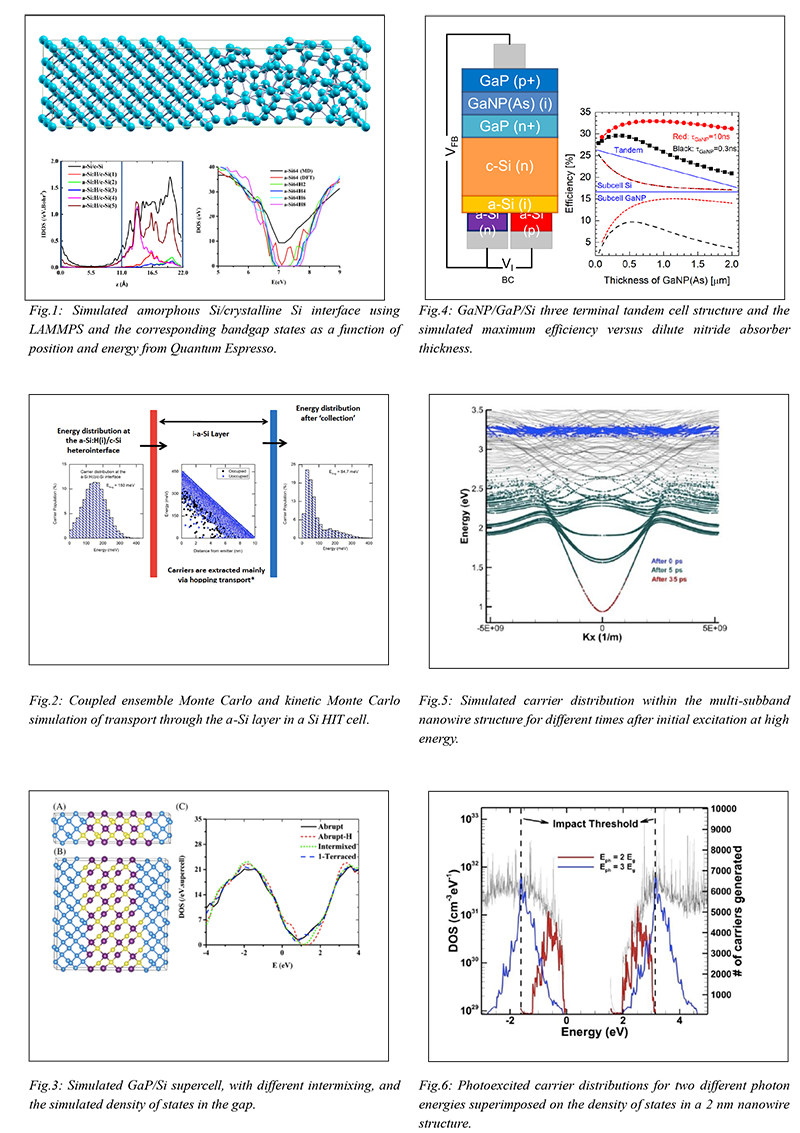IWCN 2021: Multiscale Modeling and Simulation of Advanced Photovoltaic Devices
Multiscale Modeling and Simulation of Advanced Photovoltaic Devices
-
 1. Multiscale Modeling and Simula…
0
00:00/00:00
1. Multiscale Modeling and Simula…
0
00:00/00:00 -
 2. Outline
42.07540874207541
00:00/00:00
2. Outline
42.07540874207541
00:00/00:00 -
 3. Photovoltaics (PV)
86.753420086753422
00:00/00:00
3. Photovoltaics (PV)
86.753420086753422
00:00/00:00 -
 4. Silicon Heterojunction Solar C…
275.50884217550885
00:00/00:00
4. Silicon Heterojunction Solar C…
275.50884217550885
00:00/00:00 -
 5. First Principles Study of c-Si…
462.06206206206207
00:00/00:00
5. First Principles Study of c-Si…
462.06206206206207
00:00/00:00 -
 6. Transport Through a-Si:H(i)
587.82115448782122
00:00/00:00
6. Transport Through a-Si:H(i)
587.82115448782122
00:00/00:00 -
 7. Transport Through KMC Domain
723.45679012345681
00:00/00:00
7. Transport Through KMC Domain
723.45679012345681
00:00/00:00 -
 8. Injection and Extraction
819.85318651985324
00:00/00:00
8. Injection and Extraction
819.85318651985324
00:00/00:00 -
 9. Photocurrent Suppression
872.07207207207216
00:00/00:00
9. Photocurrent Suppression
872.07207207207216
00:00/00:00 -
 10. Two Junction Si Tandems
950.91758425091757
00:00/00:00
10. Two Junction Si Tandems
950.91758425091757
00:00/00:00 -
 11. Epitaxial Combinations for Si
1068.7354020687355
00:00/00:00
11. Epitaxial Combinations for Si
1068.7354020687355
00:00/00:00 -
 12. Dilute GaNP Nitrides
1138.9389389389389
00:00/00:00
12. Dilute GaNP Nitrides
1138.9389389389389
00:00/00:00 -
 13. Tight Binding Modeling of Dilu…
1214.5812479145814
00:00/00:00
13. Tight Binding Modeling of Dilu…
1214.5812479145814
00:00/00:00 -
 14. Transport Simulation
1275.3086419753088
00:00/00:00
14. Transport Simulation
1275.3086419753088
00:00/00:00 -
 15. TCAD Device Simulation
1366.5331998665333
00:00/00:00
15. TCAD Device Simulation
1366.5331998665333
00:00/00:00 -
 16. Multi-Exciton Generation Solar…
1448.5151818485153
00:00/00:00
16. Multi-Exciton Generation Solar…
1448.5151818485153
00:00/00:00 -
 17. MEG in Nanowires
1476.1428094761429
00:00/00:00
17. MEG in Nanowires
1476.1428094761429
00:00/00:00 -
 18. Band Structure of Hexagonal Cl…
1476.9769769769771
00:00/00:00
18. Band Structure of Hexagonal Cl…
1476.9769769769771
00:00/00:00 -
 19. Scattering Rates
1480.3803803803805
00:00/00:00
19. Scattering Rates
1480.3803803803805
00:00/00:00 -
 20. Cellular Monte Carlo Simulatio…
1483.35001668335
00:00/00:00
20. Cellular Monte Carlo Simulatio…
1483.35001668335
00:00/00:00 -
 21. Carrier Generation due to Elec…
1486.252919586253
00:00/00:00
21. Carrier Generation due to Elec…
1486.252919586253
00:00/00:00 -
 22. MEG for 2 nm InGaAs with 1 nm …
1511.7117117117118
00:00/00:00
22. MEG for 2 nm InGaAs with 1 nm …
1511.7117117117118
00:00/00:00 -
 23. Acknowledgements
1541.6416416416416
00:00/00:00
23. Acknowledgements
1541.6416416416416
00:00/00:00













